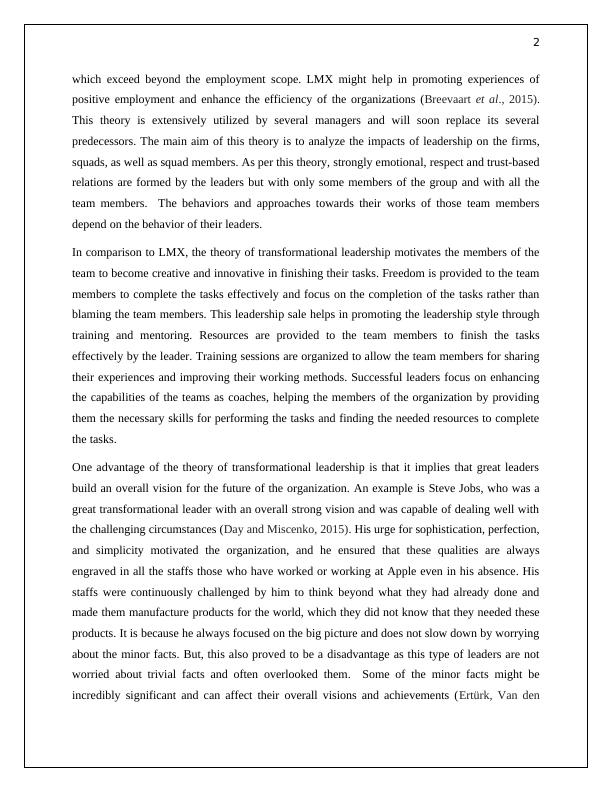Comparison and Contrast between Transformational and Leader-Member Exchange Theory
Added on 2022-11-11
7 Pages2245 Words291 Views
Leadership
Student’s Name:
Student’s ID:
Student’s Name:
Student’s ID:

1
Introduction
The essay will compare and contrast between two leadership theories, transformational
leadership theory, and leader-member exchange theory. The primary focus of the leadership
theories is to influence the behavior of individuals in the organization to make them strive
enthusiastically for achieving the targets of the organization. Leadership theories are the
implementation of leadership skills to analyze the actions of people in companies. It is essential
in organizations since it leads to better performances by the members of the team, develops the
morale and motivation in the team members and helps in responding to changes.
Thesis Statement - Leadership theories have a significant contribution to the behaviors and
performances of the teams.
Comparison and Contrast between Transformational Leader-Member Exchange Theory
Transformational leadership theory can be suggested to develop the efficiency of leadership to
manage the team. This type of leader encourages the team members by being a role model for
them and have a positive impact on the team. A transformational leader emphasizes the needs of
the team above his interests and shows the ethical code of conduct and effective practices of
work to manage the team (Abdalla et al., 2018). The leaders also connects rewards with the
efforts of the team members so that it does not feel that the employees are money making
machines for the company.
Communicating and enhancing visions are also part of this leadership theory. Visions are long
term strategies to achieve targets by connecting the present with the future of the companies.
The visions of this leadership theory satisfy the organizations and are shown in the beliefs,
actions, objectives, and values of leaders of the firms. These visions help in attracting and
affecting all the staffs those who are involved in the beliefs, actions, objectives, and values of
leaders.
On the other hand, leader-member exchange (LMX) theory is a relation centered theory which
focus on two-way relation between leaders and team members (Boer et al., 2016). It states that
leaders develops exchange of ideas among their team members. The excellence of exchange
relations affects the decisions access to resources, employee performance, and responsibilities.
Relations are established on respect and trust. Most of the time there are emotional relations
Introduction
The essay will compare and contrast between two leadership theories, transformational
leadership theory, and leader-member exchange theory. The primary focus of the leadership
theories is to influence the behavior of individuals in the organization to make them strive
enthusiastically for achieving the targets of the organization. Leadership theories are the
implementation of leadership skills to analyze the actions of people in companies. It is essential
in organizations since it leads to better performances by the members of the team, develops the
morale and motivation in the team members and helps in responding to changes.
Thesis Statement - Leadership theories have a significant contribution to the behaviors and
performances of the teams.
Comparison and Contrast between Transformational Leader-Member Exchange Theory
Transformational leadership theory can be suggested to develop the efficiency of leadership to
manage the team. This type of leader encourages the team members by being a role model for
them and have a positive impact on the team. A transformational leader emphasizes the needs of
the team above his interests and shows the ethical code of conduct and effective practices of
work to manage the team (Abdalla et al., 2018). The leaders also connects rewards with the
efforts of the team members so that it does not feel that the employees are money making
machines for the company.
Communicating and enhancing visions are also part of this leadership theory. Visions are long
term strategies to achieve targets by connecting the present with the future of the companies.
The visions of this leadership theory satisfy the organizations and are shown in the beliefs,
actions, objectives, and values of leaders of the firms. These visions help in attracting and
affecting all the staffs those who are involved in the beliefs, actions, objectives, and values of
leaders.
On the other hand, leader-member exchange (LMX) theory is a relation centered theory which
focus on two-way relation between leaders and team members (Boer et al., 2016). It states that
leaders develops exchange of ideas among their team members. The excellence of exchange
relations affects the decisions access to resources, employee performance, and responsibilities.
Relations are established on respect and trust. Most of the time there are emotional relations

2
which exceed beyond the employment scope. LMX might help in promoting experiences of
positive employment and enhance the efficiency of the organizations (Breevaart et al., 2015).
This theory is extensively utilized by several managers and will soon replace its several
predecessors. The main aim of this theory is to analyze the impacts of leadership on the firms,
squads, as well as squad members. As per this theory, strongly emotional, respect and trust-based
relations are formed by the leaders but with only some members of the group and with all the
team members. The behaviors and approaches towards their works of those team members
depend on the behavior of their leaders.
In comparison to LMX, the theory of transformational leadership motivates the members of the
team to become creative and innovative in finishing their tasks. Freedom is provided to the team
members to complete the tasks effectively and focus on the completion of the tasks rather than
blaming the team members. This leadership sale helps in promoting the leadership style through
training and mentoring. Resources are provided to the team members to finish the tasks
effectively by the leader. Training sessions are organized to allow the team members for sharing
their experiences and improving their working methods. Successful leaders focus on enhancing
the capabilities of the teams as coaches, helping the members of the organization by providing
them the necessary skills for performing the tasks and finding the needed resources to complete
the tasks.
One advantage of the theory of transformational leadership is that it implies that great leaders
build an overall vision for the future of the organization. An example is Steve Jobs, who was a
great transformational leader with an overall strong vision and was capable of dealing well with
the challenging circumstances (Day and Miscenko, 2015). His urge for sophistication, perfection,
and simplicity motivated the organization, and he ensured that these qualities are always
engraved in all the staffs those who have worked or working at Apple even in his absence. His
staffs were continuously challenged by him to think beyond what they had already done and
made them manufacture products for the world, which they did not know that they needed these
products. It is because he always focused on the big picture and does not slow down by worrying
about the minor facts. But, this also proved to be a disadvantage as this type of leaders are not
worried about trivial facts and often overlooked them. Some of the minor facts might be
incredibly significant and can affect their overall visions and achievements (Ertürk, Van den
which exceed beyond the employment scope. LMX might help in promoting experiences of
positive employment and enhance the efficiency of the organizations (Breevaart et al., 2015).
This theory is extensively utilized by several managers and will soon replace its several
predecessors. The main aim of this theory is to analyze the impacts of leadership on the firms,
squads, as well as squad members. As per this theory, strongly emotional, respect and trust-based
relations are formed by the leaders but with only some members of the group and with all the
team members. The behaviors and approaches towards their works of those team members
depend on the behavior of their leaders.
In comparison to LMX, the theory of transformational leadership motivates the members of the
team to become creative and innovative in finishing their tasks. Freedom is provided to the team
members to complete the tasks effectively and focus on the completion of the tasks rather than
blaming the team members. This leadership sale helps in promoting the leadership style through
training and mentoring. Resources are provided to the team members to finish the tasks
effectively by the leader. Training sessions are organized to allow the team members for sharing
their experiences and improving their working methods. Successful leaders focus on enhancing
the capabilities of the teams as coaches, helping the members of the organization by providing
them the necessary skills for performing the tasks and finding the needed resources to complete
the tasks.
One advantage of the theory of transformational leadership is that it implies that great leaders
build an overall vision for the future of the organization. An example is Steve Jobs, who was a
great transformational leader with an overall strong vision and was capable of dealing well with
the challenging circumstances (Day and Miscenko, 2015). His urge for sophistication, perfection,
and simplicity motivated the organization, and he ensured that these qualities are always
engraved in all the staffs those who have worked or working at Apple even in his absence. His
staffs were continuously challenged by him to think beyond what they had already done and
made them manufacture products for the world, which they did not know that they needed these
products. It is because he always focused on the big picture and does not slow down by worrying
about the minor facts. But, this also proved to be a disadvantage as this type of leaders are not
worried about trivial facts and often overlooked them. Some of the minor facts might be
incredibly significant and can affect their overall visions and achievements (Ertürk, Van den

End of preview
Want to access all the pages? Upload your documents or become a member.
Related Documents
Relationship between Authentic Leadership, Leader-Member Exchange and Psychological Capitallg...
|10
|2780
|465
Organization Citizenship Behavior Assignmentlg...
|6
|1550
|28
Comparison of Transformational Leadership and Leader-Member Exchangelg...
|9
|1586
|156
Psychological Capital of different staffslg...
|9
|2425
|18
Introduction to Psychological Capitallg...
|14
|3719
|146
Comparison of Transformational and LMX Leadership Theorieslg...
|9
|2438
|47